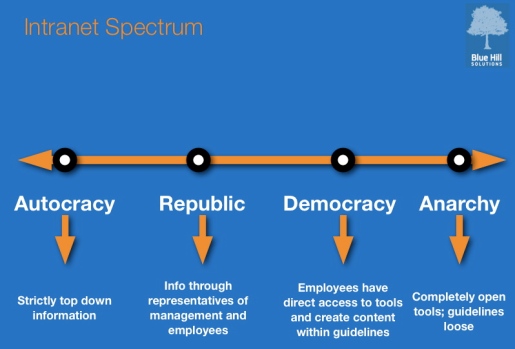I was quoted in a recent article entitled, “Corporate intranets are in deep trouble, expert says“. Don’t worry, I am not the expert in the title, so this post is not a big pat on the back for myself. However, it did prompt me to share something that has been incubating for a while in my communicator brain — the intranet spectrum.
I have tried this concept out on two different seminar audiences and received good feedback. The best feedback, is of course, when your ideas are integrated into the way someone talks about a subject. And “the intranet spectrum” seems to do just that. It gets people talking about the intranet with a unified vocabulary and a vocabulary we are all familiar with.
I will be talking more about this spectrum in reference to the tools I feature here on my blog, so let me introduce you to the concept. Talking about the intranet (the intranet’s primary purpose is to distribute information effectively) using an analogy of government systems (a government’s primary purpose is to distribute resources) allows organizations and communicators to place their own intranet and intranet tools along a continuum which can be easily mapped to culture development within the organization. So just as government systems use varying methods and political ideologies for distributing resources, so can organizations use varying intranet tools and communication philosophies to distribute information to employees.

In my seminars, I have asked participants to place their own intranet on the spectrum. When doing this, the most important thing to keep in mind is that none of the points on the intranet spectrum are “bad” or “good” — where your intranet falls on the spectrum should relate directly to the kind of culture you are trying to develop inside your organization. And remember that the spectrum can also apply at the tool level. Your overall intranet might be “democratic”, but you may have some tools that are still “autocratic”. For example, perhaps you have instituted forums with anonymous comments for employees to engage in dialogue, but all of your corporate articles are still vetted through an approval process through senior management.
The spectrum can also give you a strategic roadmap for convincing your leaders to share in your vision for developing your intranet. You can bridge their plans for development of the business culture, by using a shared vocabulary for talking about your plan for the intranet and how your communication strategy can help them achieve their vision for the organization.
Helpful tip!
Don’t feel tied to using the political system labels if they might turn off your leaders. Some leaders may not be able to see how an “anarchic” tool would work in their organization. If you are concerned about the labels, use the descriptions to guide your discussions with your leaders about intranet vision. However, I think a good shock to the system a la anarchy might be just the jolt corporate leaders need to get on the bandwagon for the intranet of the future!
Leave a comment